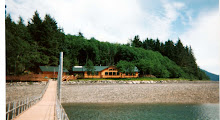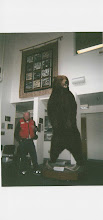by Robert L Gisel
My Dad was a genuine Alaska Bush Pilot. It was for that that we moved to Alaska in a long exodus from Texas. Rumor had it the 49th State was going to broken up into two States and then Texas would be the third largest State in the US.
Originally my dad, Charles A. Gisel Jr, went into the Army Air Force to become a pilot. That ambition was denied him as he was color blind, only saw things in black and white, shades of gray, so he was put into radio communications training instead. He went into a classified project I only found out about inadvertently reading a book on it much later. The experiment was to fly remote controlled airplanes while the Army Air Corps developed a method of flying pilot-less planes or drones into the guns of Navarone for D-Day.
After the service he did a remarkable thing. Somehow getting a copy of the color charts used for the tests he memorized the shades of gray until he could name all the colors. In this way he got his pilot's license and went on to be, ironically enough, a Civilian Flight Instructor for the Army. So he started training the Army's pilots in the Bird-dog Trainer.
The rule of thumb of the Army for its pilot Instructors was to transfer them around a lot. The think was that if they allowed one to stay in a location for longer than 18 months they would want to stay and they wouldn't accept a transfer to the next base they would be needed at. This meant for me many different homes and many moves to different states.
From where I was born in Kansas we went to Oklahoma, to Alabama, back to Kansas, then to Texas all by the age of 7. There in San Marcos, Texas I started second grade. The Army then violated its rule and we stayed living in Texas for 2 1/2 years. When it came time to transfer us again back to Alabama we didn't want to. Not just my Dad but none of us in my family wanted to go to Alabama again. The rule in Mobile, Alabama, is that if it rains on Monday it will rain all the rest of the week. There was more to the decision than just the weather but that is where Dad quit the Civilian Army Flight Instructor business.
By the time he was training pilots at Ft. Hood Dad was now also giving flight instruction in larger planes and even helicopters all the way up to the big transports my brother and I called the flying banana. This led to Dad getting a job flying for Era Copters in the summer of 1959. The job was to transport Japanese Glaciologists around in Glacier Bay for their exploratory work. He was to learn some things about what makes being a Bush Pilot so dangerous at times.
Picking up a Hiller 12-E helicopter at Era Copters in San Francisco Dad flew it to Glacier Bay for the summer contract. There he had a white-out and crashed.
A white-out is a blizzard, in this case where the snow gets stirred up by the propellers, flies up all around until you can't see anything, except white snow. A guiding principle in flying a helicopter is to keep your eyes on the horizon thus keeping your orientation. When in the middle of a white-out you not only can't see the horizon you also can't tell which direction you are going. Thinking he was going forward when instead he was going backwards the tail rudder hit the ice followed by the main rotors and the helicopter beat itself to pieces.
Seeing the photo of the wreckage which was no longer remotely identifiable as a helicopter I asked my Dad how he walked away from that. He says he just unstrapped and stepped out. He flew back to San Francisco and picked up another 12-E and went back to complete the contract at Glacier Bay. One gets the idea this was a sort of inner circle Bush Pilot's initiation: crashes happen.
After that however they adopted a technique of using lamp black to mark the landing area first. A long section of stove pie is hung out the open door towards the ground and lamp black, soot, is dumped in it to lay a black line on the landing area. This worked pretty well apparently, except the one time they got too close to the ground. The back-wash from the rotors blew the soot back up the stove pipe into the cockpit. Now they had a black-out. Well that one came out okay as Dad took it back up, instrument flying, until they could clean off the inside of the bubble and land safely.
By the time Dad had finished flying the contract At Glacier Bay he had landed another job in Alaska. He was going to be a Bush Pilot for Dean Goodwin's Flying Service in Juneau. Dean had a couple Cessna 180 float planes and also a Beaver and an Otter both on floats. The real clincher was he also had a Hiller 12-E helicopter. Dad was set. This was the ideal scene, doing what he loved the most and in the idyllic environment of Alaska.
Just as winter was setting in we set off for Alaska in a caravan of two vehicles, towing two trailers, a packed 16 foot trailer and a 16 foot boat on its trailer. That was a long trip, not that I cared about that as this was the kind of adventure that thrills the life of a nine year old.
When we finally arrived Dad again had to set about another memorization task: the topographical maps of Southeast Alaska. He had me grill him on where things were on the map. This was primarily because this is not where you fly around from airport to airport with an abundance of beacons and navigational aids. There would none of that and with wild and fast weather changes there was no substitute for knowing the terrain and how to get around by sight alone. This was flying in the wild.
Dad started going out to canneries and villages in the float plane and taking Geologists on minerals surveys around Admiralty Island then another contract came up with the Japanese Glaciologists, this time at Mendenhall Glacier.
One day Dean Goodwin came flying in in a super rush and landed the 180 at our boat dock on Fritz Cove Road. He ran up to the house without saying anything leaving my brother and I to corral the plane coasting by the dock and tie it off to worry about what had happened as this was a very unusual event. Turns out Dad had had another crash, this time on the Mendenhall Glacier. Dean wanted Mom to know about it before she heard about it on the news, and to know that no one was hurt, Dad was okay.
Dad told me later how it happened. Flying in 100 feet over the glacier the carburetor iced up and killed the engine. Dad looked for the flattest place he could find and started auto-rotating for it. Feathering the rotors at the last moment the copter plopped on the ice, on the rubber pontoons. It then started a slide to the right into a crevasse that was 16 feet deep. The one on the left side it turns out was over a 100 feet deep. The copter dropped into the crevasse and beat itself apart.
The straight up walls of ice were too high to climb up out of. Being lost to sight in the middle of such huge expanse of glacier it would be weeks before anyone found them so rescue didn't look too promising. One of the Glaciologists had a dislocated shoulder as he was the third man on the bottom when the whirlybird came to rest but there were fortunately no other injuries. Forming a human pyramid with one Glaciologist standing on the shoulders of the other then Dad climbing up on top of him this was high enough to use the ice picks and get free.
From there it was just a matter of hiking off the glacier to a house where he made the phone call for help. The Coast Guard came and retrieved the two still in the crevasse.
Dad went on to live another eight years of flying, sometimes in the hardest of conditions until it was finally a faulty Fairchild Hiller that took him down. The error in the new cowling design permitted snow to sluff into the engine and kill it. This took it's toll during a critical takeoff at Snettisham Dam Project resulting in a brutal crash.
He was extremely well loved and admired. Now we all miss him. He leaves behind some good memories and the mountain Gisel Peak, named in his honor.
Friday, April 4, 2008
Subscribe to:
Post Comments (Atom)











No comments:
Post a Comment